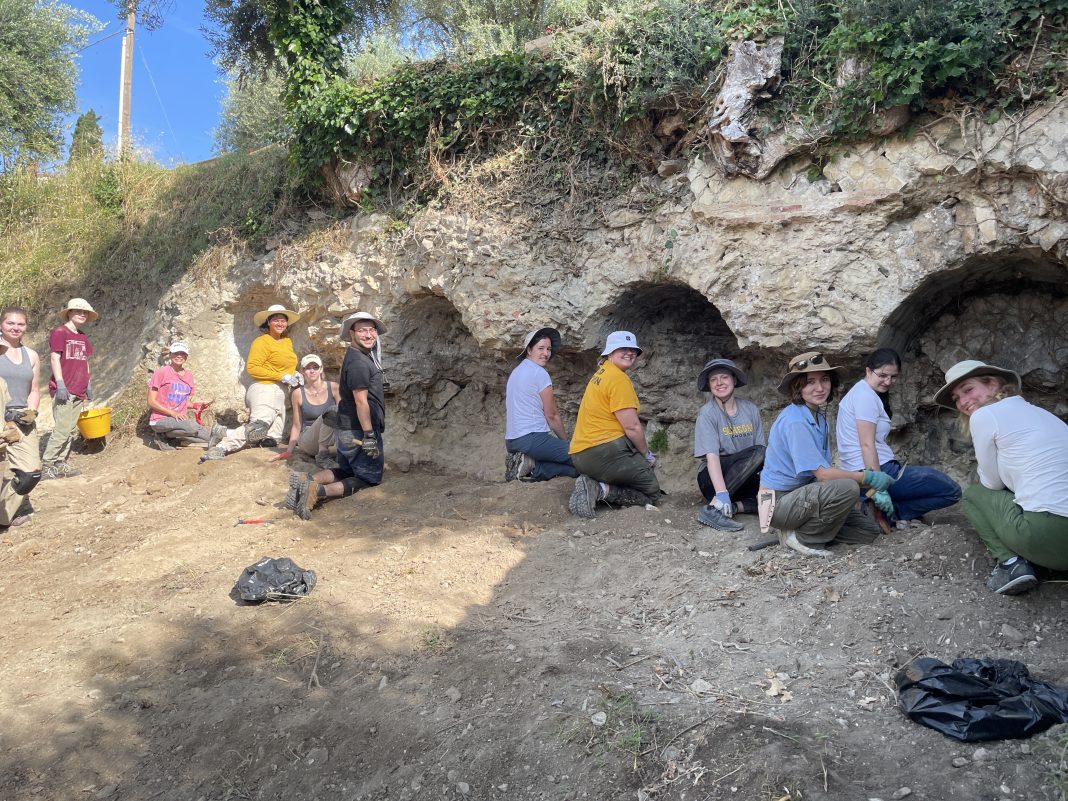In the heat of an Italian summer, collegiate archeologists stand knee-deep in the dusted stone of half-buried ruins, unearthing fragments of ancient civilizations. DePauw students and faculty alike peer into the past through technology both old and new, digging into structures once thought lost. While investigating a brand new site, this group of DePauw’s budding archeologists found much more than they expected: an entire ancient structure buried beneath centuries of earth.
Participating in DePauw’s partnership with the Umbra Institute of Perugia and the Trasimeno Field School, these students traveled abroad to a region in Italy that was virtually unexplored through scientific archeology, yet brimming with discoveries dating back to ancient Roman civilization and beyond.
Coming from all sorts of backgrounds and prospective majors, these students found their way to Castiglione del Lago, ready to spend six weeks working with archeologists and pursue their passions for discovery. However, none of them expected to discover so much. Beyond a long-standing wall, which had been an ancient fixture in the town, they discovered ruins on two further terraces. On the first, they found a complex underground structure, and then on the next, a sprawling paved surface.
“We had seen it before, we had documented it on this map that we had made, but we didn't really think very much of it because it was clear that it had already been carved away. We thought that if there was anything above it, on the terrace above that, it would not be very well preserved.” said Rebecca Schindler, Professor of Classical Studies and the scientific director for the project.
“They actually filled in the terrain and then leveled it off, and in doing that, what they did was they preserved the Roman structures underneath. So nobody anticipated that we would find as much of the site preserved as it is, or that it was as deep as it is,” Schindler said.
DePauw students have been to similar sites across Italy since 2015, yet this one in 2023 yielded the most discoveries since the program began. The form and function of these new ruins remains a mystery. , Despite this summer’s progress, this group has only scratched the surface. The excavation has only just begun.
However, that’s not to say that these sorts of trips don’t have benefits for the students and universities alike.
“The program is a masterclass in teaching you not only the archaeological skills you’ll need if you’re looking to continue your work in the field but also forces you outside of your comfort zone. Because of my return from last year, I was in a leadership role with quite a bit of responsibility as far as using the skills from last year and applying them again with new people! It’s hard to try to make new friends in a stressful environment, but that’s what the experience is for,” Junior Morgan Lawson, a multi-year participant in this program, said.
Like Lawson, many students who participated in the program are grateful for the experience and look forward to continuing their work on the summer’s findings. Students from all sorts of majors, whether or not they study archaeology at all, poured weeks of work into their discoveries back in Italy. With the site completely preserved until the group returns next year, many hope to see what else it will have to offer. Even those graduating from DePauw have found themselves inspired by the experience, and hope to continue it in their own paths.
“Following the events of this program, I am looking forward to finishing out my last year at DePauw University. I also hope to join the Trasimeno Regional Archaeological Project in the summer of 2024 to help refine my application of archaeological methods and possibly learn more about the archaeological use of GIS and digital rendering technology,” Senior Solomon Alhakeem, another student participant in the summer’s project, said.
This past summer, a group of fortunate students achieved a great archeological feat and unearthed something many thought was lost to time. Though their work has much longer to go, and these students have their own paths to take, and their summer has not gone unnoticed. The world can only wait to see what else they and their program find next.
“Archaeology, like many disciplines that explore the past, is about trying to put together puzzle pieces,” said Schindler. “Working with archaeological evidence is like having a 5000-piece puzzle, but you only have 1000 of the pieces and you're not always sure where to go. As archaeologists, every once in a while, we get the privilege and the opportunity to uncover another piece, and we get another little window right into what the puzzle truly looks like.”

